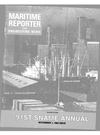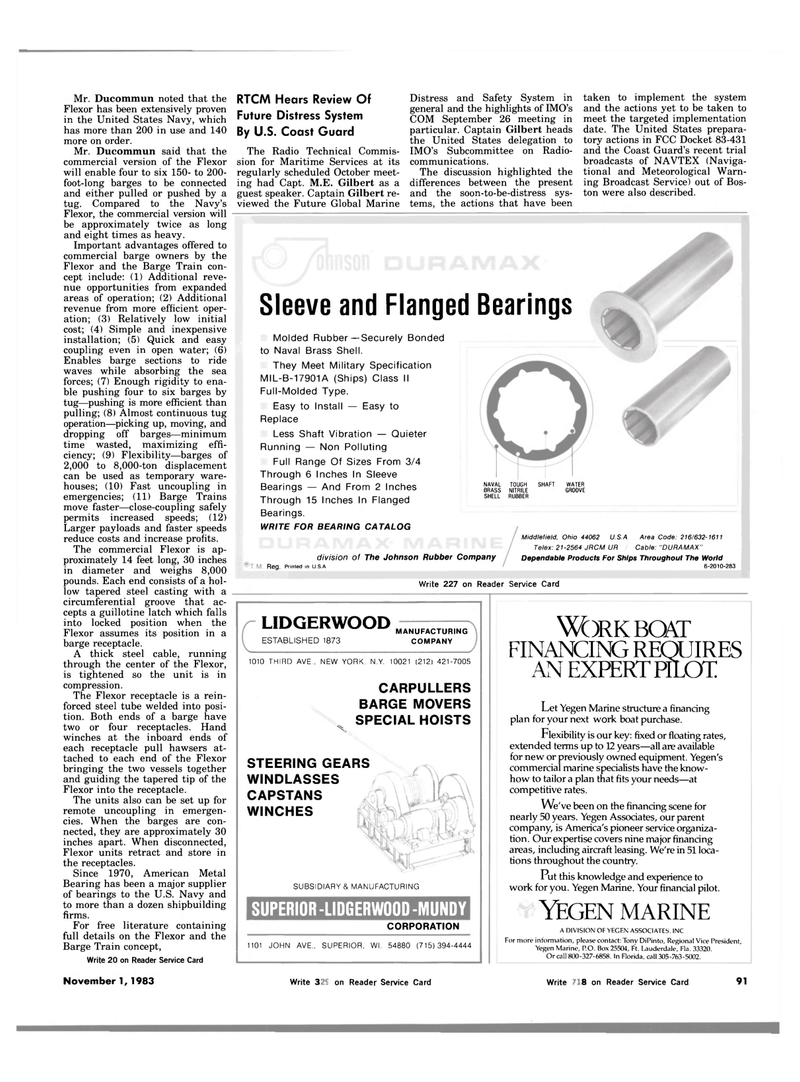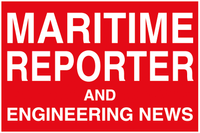
Page 89: of Maritime Reporter Magazine (November 1983)
Read this page in Pdf, Flash or Html5 edition of November 1983 Maritime Reporter Magazine
Mr. Ducommun noted that the
Flexor has been extensively proven in the United States Navy, which has more than 200 in use and 140 more on order.
Mr. Ducommun said that the commercial version of the Flexor will enable four to six 150- to 200- foot-long barges to be connected and either pulled or pushed by a tug. Compared to the Navy's
Flexor, the commercial version will be approximately twice as long and eight times as heavy.
Important advantages offered to commercial barge owners by the
Flexor and the Barge Train con- cept include: (1) Additional reve- nue opportunities from expanded areas of operation; (2) Additional revenue from more efficient oper- ation; (3) Relatively low initial cost; (4) Simple and inexpensive installation; (5) Quick and easy coupling even in open water; (6)
Enables barge sections to ride waves while absorbing the sea forces; (7) Enough rigidity to ena- ble pushing four to six barges by tug—pushing is more efficient than pulling; (8) Almost continuous tug operation—picking up, moving, and dropping off barges—minimum time wasted, maximizing effi- ciency; (9) Flexibility—barges of 2,000 to 8,000-ton displacement can be used as temporary ware- houses; (10) Fast uncoupling in emergencies; (11) Barge Trains move faster—close-coupling safely permits increased speeds; (12)
Larger payloads and faster speeds reduce costs and increase profits.
The commercial Flexor is ap- proximately 14 feet long, 30 inches in diameter and weighs 8,000 pounds. Each end consists of a hol- low tapered steel casting with a circumferential groove that ac- cepts a guillotine latch which falls into locked position when the
Flexor assumes its position in a barge receptacle.
A thick steel cable, running through the center of the Flexor, is tightened so the unit is in compression.
The Flexor receptacle is a rein- forced steel tube welded into posi- tion. Both ends of a barge have two or four receptacles. Hand winches at the inboard ends of each receptacle pull hawsers at- tached to each end of the Flexor bringing the two vessels together and guiding the tapered tip of the
Flexor into the receptacle.
The units also can be set up for remote uncoupling in emergen- cies. When the barges are con- nected, they are approximately 30 inches apart. When disconnected,
Flexor units retract and store in the receptacles.
Since 1970, American Metal
Bearing has been a major supplier of bearings to the U.S. Navy and to more than a dozen shipbuilding firms.
For free literature containing full details on the Flexor and the
Barge Train concept,
Write 20 on Reader Service Card
LIDGERWOOD
ESTABLISHED 1873
MANUFACTURING
COMPANY 1010 THIRD AVE.. NEW YORK, N.Y 10021 (212) 421-7005 %
CARPULLERS
BARGE MOVERS
SPECIAL HOISTS
STEERING GEARS
WINDLASSES
CAPSTANS
WINCHES
SUBSIDIARY & MANUFACTURING
SUPERIOR -LIDGERWOOD -MUNDY
CORPORATION 1101 JOHN AVE., SUPERIOR, Wl. 54880 (715)394-4444
WLK BOAT
FINANCING REQUIRES
AN EXPERT PILOT
Let Yegen Marine structure a financing plan for your next work boat purchase.
Flexibility is our key: fixed or floating rates, extended terms up to 12 years—all are available for new or previously owned equipment. Yegen's commercial marine specialists have the know- how to tailor a plan that fits your needs—at competitive rates.
We' ve been on the financing scene for nearly 50 years. Yegen Associates, our parent company, is America's pioneer service organiza- tion. Our expertise covers nine major financing areas, including aircraft leasing. We're in 51 loca- tions throughout the country.
Put this knowledge and experience to work for you. Yegen Marine. Your financial pilot.
YEGEN MARINE
A DIVISION OF YEGEN ASSOCIATES, INC
For more information, please contact: Tony DiPinto, Regional Vice President,
Yegen Marine, P.O. Box 25504, Ft. Lauderdale, Fla. 33320.
Or call 800-327-6858. In Florida, call 305-763-5002.
RTCM Hears Review Of
Future Distress System
By U.S. Coast Guard
The Radio Technical Commis- sion for Maritime Services at its regularly scheduled October meet- ing had Capt. M.E. Gilbert as a guest speaker. Captain Gilbert re- viewed the Future Global Marine
Distress and Safety System in general and the highlights of IMO's
COM September 26 meeting in particular. Captain Gilbert heads the United States delegation to
IMO's Subcommittee on Radio- communications.
The discussion highlighted the differences between the present and the soon-to-be-distress sys- tems, the actions that have been taken to implement the system and the actions yet to be taken to meet the targeted implementation date. The United States prepara- tory actions in FCC Docket 83-431 and the Coast Guard's recent trial broadcasts of NAVTEX (Naviga- tional and Meteorological Warn- ing Broadcast Service) out of Bos- ton were also described.
Sleeve and Flanged Bearings
Molded Rubber— Securely Bonded to Naval Brass Shell.
They Meet Military Specification
MIL-B-17901A (Ships) Class II
Full-Molded Type.
Easy to Install — Easy to
Replace
Less Shaft Vibration — Quieter
Running — Non Polluting
Full Range Of Sizes From 3/4
Through 6 Inches In Sleeve
Bearings — And From 2 Inches
Through 15 Inches In Flanged
Bearings.
WRITE FOR BEARING CATALOG division of The Johnson Rubber Company
Reg. Printed in u S A
NAVAL
BRASS
SHELL
TOUGH
NITRILE
RUBBER
SHAFT WATER
GROOVE
Middlelield, Ohio 44062 U S A
Telex: 21-2564 JRCM UR
Area Code: 216/632-1611
Cable: "DURAMAX"
Dependable Products For Ships Throughout The World 6-2010-283
Write 227 on Reader Service Card
November 1, 1983 Write 238 on Reader Service Card Write 380 on Reader Service Card 91

 88
88

 90
90
